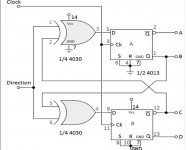cwathen
Experienced Member
My 5150 randomly stopped booting from disk (original full height Tandon 360K drive), the disk would spin but it would quickly give up and drop to BASIC.
This was quickly traced to the floppy drive itself, so I pulled the drive out and installed it on another machine as drive B:
It was unable to read any disks. I put in a fresh disk and tried to format it, it appeared to be doing so and counted up all 39 tracks but it didn't sound right (you couldn't hear the 'click' as it steps over each track) then failed on track 0 right at the end.
Taking the PCB off the top of the drive quickly revealed the problem - the head was stuck in the centre of the disk and just banging against the stop, trying to format the same track over and over again. The head assembly did freely move over the rails, so I pushed it all the way back to the outside of the disk and tried the format again in case the drive had somehow got 'confused' about where the head was on the disk.
This time it correctly formatted all the tracks but the format failed again at the end ('Cannot write boot') as the head wasn't able to move back to the outside to complete the format.
Somehow the stepper motor is only able to drive the head assembly in one direction. There is no obstruction in the head assembly's path, nothing wrong with the ability to move it by hand over the rails with power off, no damage to the stepper motor's wires that I can see either.
This one has me completely stumped, this drive has never given me the slightest problem before.
This was quickly traced to the floppy drive itself, so I pulled the drive out and installed it on another machine as drive B:
It was unable to read any disks. I put in a fresh disk and tried to format it, it appeared to be doing so and counted up all 39 tracks but it didn't sound right (you couldn't hear the 'click' as it steps over each track) then failed on track 0 right at the end.
Taking the PCB off the top of the drive quickly revealed the problem - the head was stuck in the centre of the disk and just banging against the stop, trying to format the same track over and over again. The head assembly did freely move over the rails, so I pushed it all the way back to the outside of the disk and tried the format again in case the drive had somehow got 'confused' about where the head was on the disk.
This time it correctly formatted all the tracks but the format failed again at the end ('Cannot write boot') as the head wasn't able to move back to the outside to complete the format.
Somehow the stepper motor is only able to drive the head assembly in one direction. There is no obstruction in the head assembly's path, nothing wrong with the ability to move it by hand over the rails with power off, no damage to the stepper motor's wires that I can see either.
This one has me completely stumped, this drive has never given me the slightest problem before.

